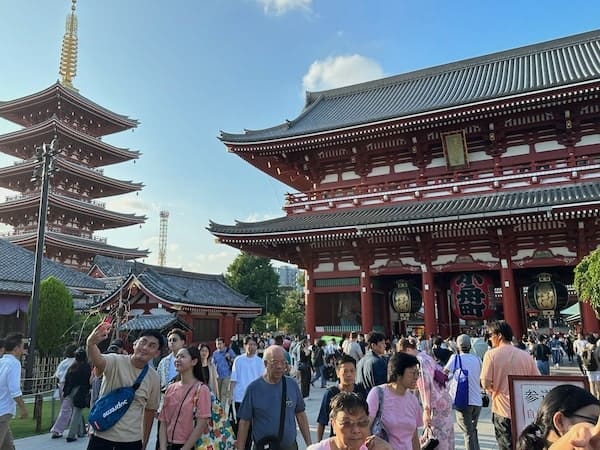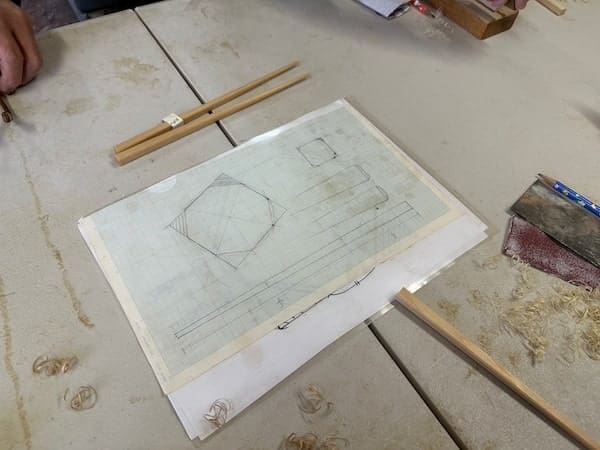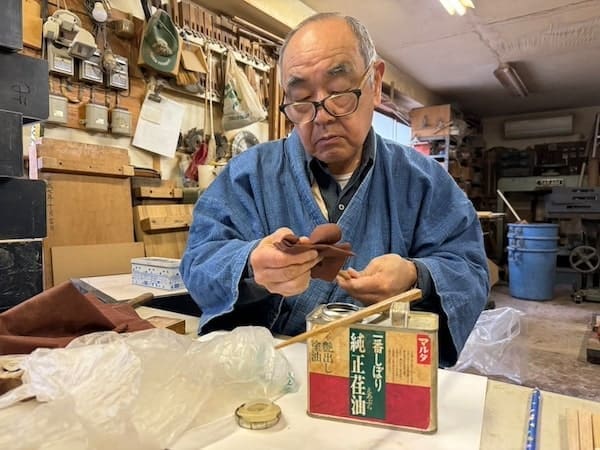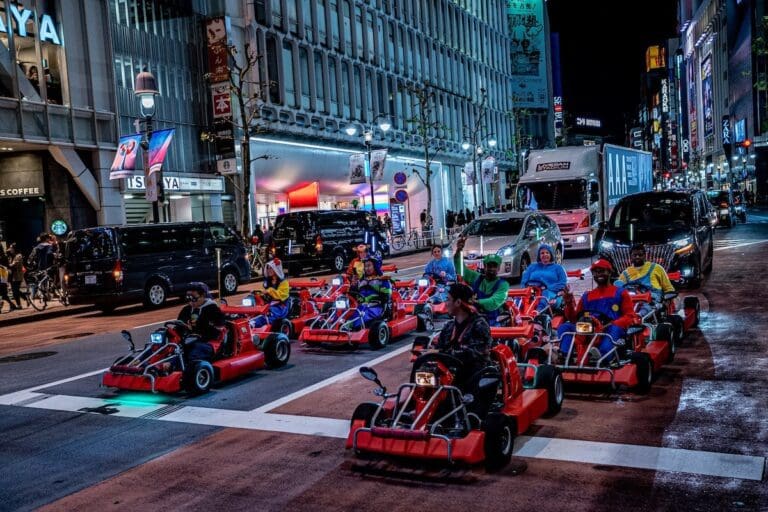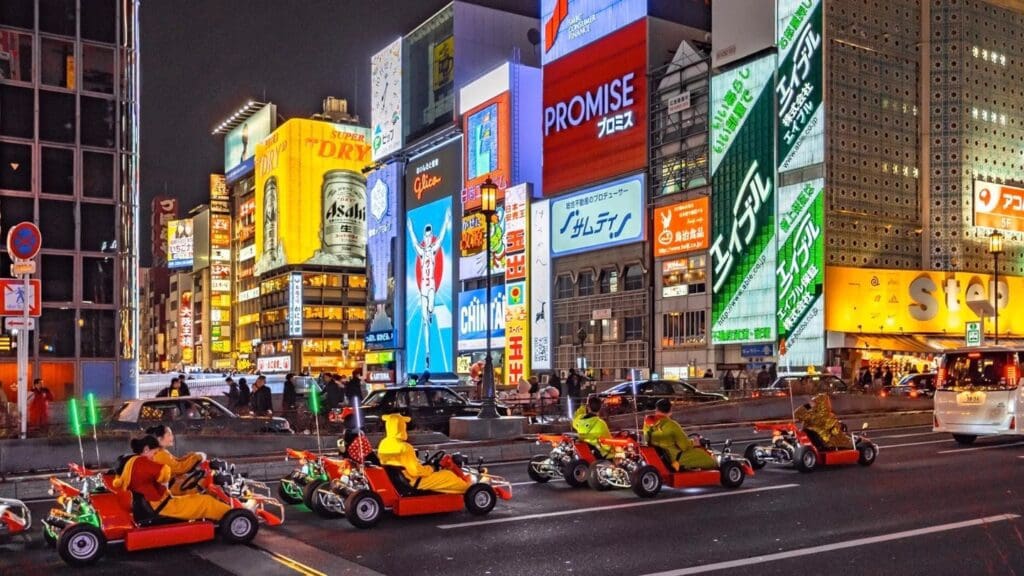First time I visited an observation deck in Tokyo, I just wanted that typical skyline photo. But after a while living here and working in the travel industry, I realized there’s a lot more to these city views than just ticking off the big towers. Tokyo’s cityscape changes shape depending on where you stand: one moment you’re above a sprawl of blinking mini-towers, the next you’re looking down at trains twisting through old neighborhoods or, if you time it right, seeing Mount Fuji glowing on the edge. In this article, I break down the main sky decks everyone mentions, but also the quieter alternatives you can use on packed days, the rooftop bars that give you the same views with a drink in hand, and practical tips to actually enjoy the skyline (not just stand in line for it). If you want to see Tokyo from above, here’s how to make it worth your time and money.
Tokyo City Views in a Nutshell
If you’re short on time, here’s the article in a nutshell.
The best all-around pick is Shibuya Sky for an open-air rooftop and clean photos at sunset. Book ahead and plan to arrive 60–90 minutes before sunset. Tokyo Tower gives a classic, central view from inside, but it often looks better photographed from elsewhere. Skytree wins on height and daytime orientation, with Fuji on clear days, though night views can feel like a flat carpet of lights. Roppongi Hills’ Tokyo City View frames Tokyo Tower perfectly and is usually calmer than the big hitters; note the rooftop has been closed to the public since 2023.
Great alternatives if tickets sell out or you want to save money: the free Tokyo Metropolitan Government Building in Shinjuku, Yebisu Garden Place Sky Lounge for an easy Tokyo Tower angle, and Sunshine 60’s Sky Circus in Ikebukuro, which notably allows tripods. Bunkyo Civic Center is closed until early December 2026. Azabudai Hills’ 33rd-floor skylobby is now limited to patrons.
Smart strategy: pair one paid deck with a relaxed view where you can sit. Try Andaz Toranomon Hills’ rooftop bar, the bar at Prince Park Tower Tokyo for close Tokyo Tower shots, or the Mandarin Oriental’s lounge for sweeping vistas. For rooms, book a Tower View at Prince Park Tower or Tokyo Prince. General tips: most decks ban tripods and have bag rules, glass reflections are a pain after dark, winter brings the best Fuji chances, weekdays are quieter, and if you want photos of Tokyo Tower or Skytree, shoot them from another viewpoint.
Iconic Tokyo Observation Decks
Tokyo has a lot of viewpoints, but a handful define the skyline experience. These are the places I recommend to almost everyone, because they each offer something different: record-breaking height, classic central views, or an open-air rooftop where you can feel the wind while the city lights switch on. If you have time, I usually recommend going in the afternoon while it’s still daylight, staying for sunset, and waiting until night. The day and night views are completely different, and sunset is the best of all.
Tokyo Skytree
Japan’s tallest structure is a spectacle from the ground and even more so from the top. Skytree has two decks: the Tembo Deck at 350 m and the Tembo Galleria at 450 m. The Tembo Deck is where you linger, with a cafe, shops, and plenty of glass for that “Google Earth” feeling. The Galleria is a glass-and-steel ramp that spirals even higher, and I like it for the pure sci‑fi vibe as much as the view.

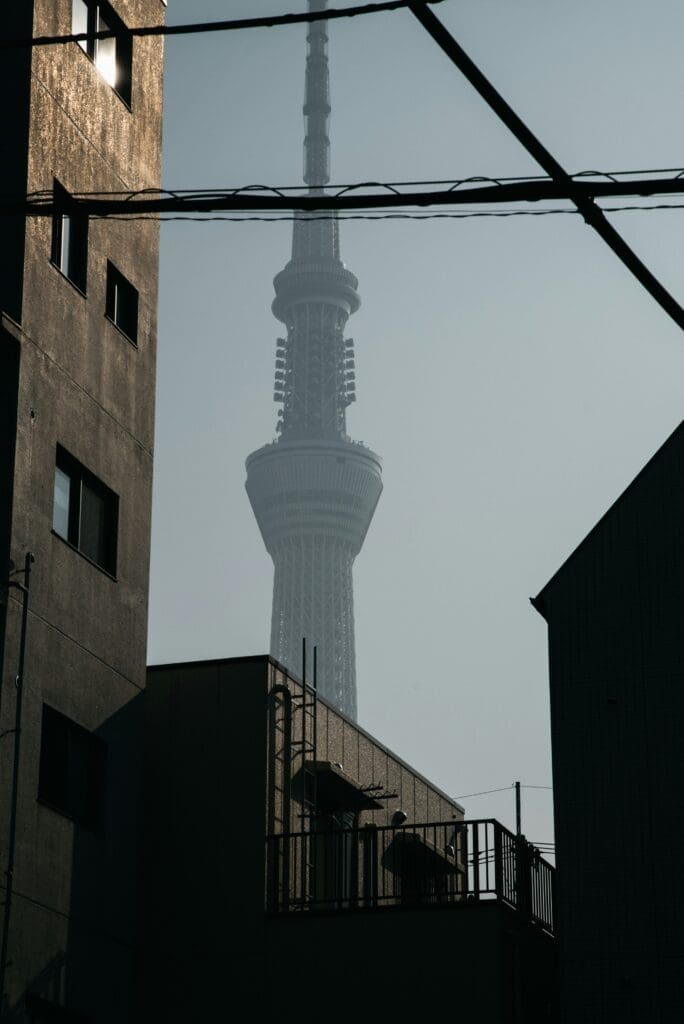
What you see: all of Tokyo spread like a circuit board, the Sumida River winding below, and on clear days Mount Fuji in the distance. Because Skytree sits away from Shinjuku and Roppongi, you are above the skyline rather than in it. That makes daytime outstanding for orientation, but at night, the city can blur into a carpet of lights with fewer recognizable anchors.
Practical notes:
- Tickets vary by date, but roughly ¥2,100 for Tembo Deck and around ¥3,100 for both decks, and prices can reach respectively ¥2,300 and ¥3,400 on peak dates. Note that same-day tickets are 10-15% more expensive. Online tickets often have a small discount and help you skip long lines, so I recommend buying in advance either on Klook, or Viator.
- Typical hours are 10:00 to 21:00, and poor weather can shut down views or the decks themselves. If the forecast looks iffy, I skip it and try another day.
- Tripods are prohibited.
- Pairing Skytree with Asakusa works well. I recommend visiting Sensoji in the morning, then heading over to Skytree for a clear daytime view. If you get clouds, Solamachi, the Sumida Aquarium, and the Tenku Planetarium at the base fill a few hours easily.
Personal take: I actually prefer Skytree from the outside rather than the inside. The structure is huge (so huge that I can see it from the balcony of my four-story building 10 km away) and it’s visible from countless streets and view points across the city. I’ve spotted it so many times from different angles that I’ve thought about making my own modern “Thirty-six Views of Skytree” like Hokusai’s Mount Fuji series. Once you’re inside, the observatory is so high up that the view feels almost like looking at a drone shot. The tower itself is the most impressive structure among them all, but when it comes to observatories, it’s probably my least favorite.

Tokyo Tower
Tokyo Tower is the classic. Built in 1958 and standing 333 m, it still feels like the city’s heartbeat. There are two decks: the Main Deck at 150 m and the Top Deck at 250 m, which needs a reservation and often sells out. From the decks you can pick out Skytree, Zojoji Temple below, and on a clear day Mount Fuji. The central perspective is what makes it special, it sits right in Minato so you are surrounded by the city rather than looking at it from afar.
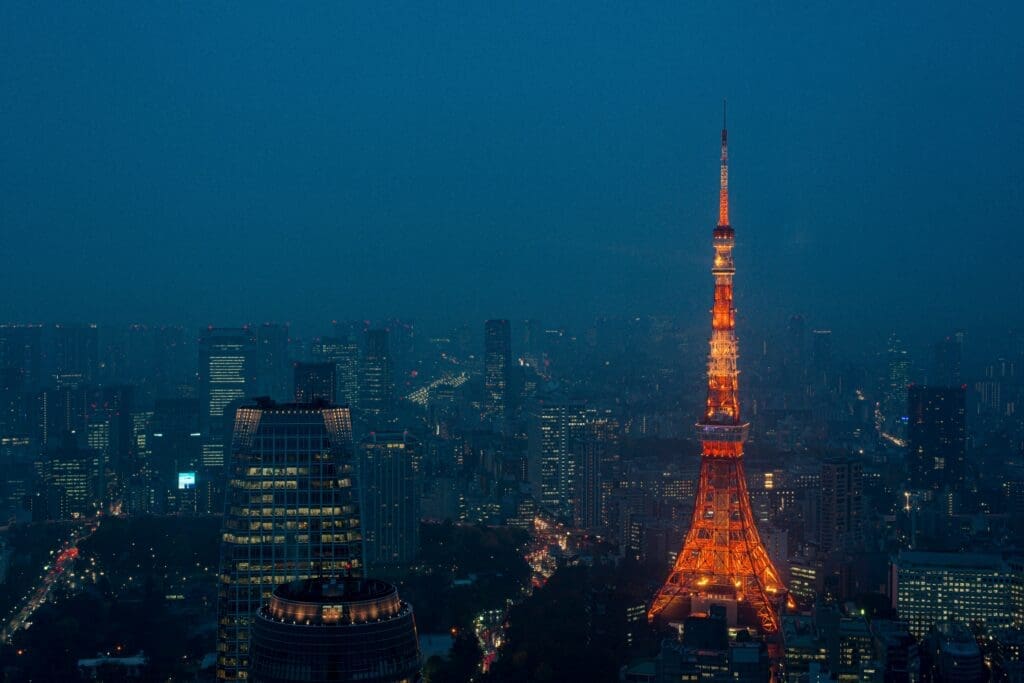
Admission is typically around ¥1,500 for the Main Deck and ¥3,300 for the Top Deck, or ¥7,000 for both but also giving you access to the lounge and you will be guided by a dedicated performer and attendant. Opening hours are from 9:00 to 23:00, last entry 22:30. You can book your tickets online on Klook.
Facilities on lower floors include shops and casual restaurants, handy if you are visiting with kids or just want a quick bite. Tripods are not allowed, and internal lighting can reflect in glass at night, so I recommending pressing your lens to the window and use a sleeve to block reflections.
Personal take: While the view from inside Tokyo Tower is good, I think it’s even more impressive to see it as part of the skyline from a nearby viewpoint. As one of Tokyo’s most iconic landmarks, it stands out most when you can take in its full shape and color at night when it is brightly lit.
Shibuya Sky
Shibuya Sky sits above Shibuya Scramble Square and is the most fun modern rooftop in Tokyo. The open-air deck is about 230 m up, and the design is all about hanging out: stepped seating, a lounge-like feel, and a 360-degree sweep with nothing taller nearby. On a clear afternoon you can line up Shinjuku’s towers, Roppongi, Skytree to the east, and Mount Fuji glowing at sunset in the west. You can also peek down to the famous crossing, though it is so high that it feels more like a model than a street scene.

- Admission is ¥2,700 per adult for admission before 15:00, but ¥3,400 after that. Hours are 10:00 to 22:30 daily. Tickets often sell out for sunset, so I recommend booking ahead on Klook and aim to arrive 60–90 minutes before sunset to watch the city change.
- Bags are not allowed on the rooftop itself, lockers are provided at the top. I keep a 100 yen coin ready for the locker, you get it back after.
- There are indoor areas with a lounge, snack bar, and souvenir shop if the wind picks up.
- If you want to linger, limited sofa seating exists on the rooftop by reservation and it books fast.
- It is currently the standout open-air experience in central Tokyo, especially since other rooftops have tightened access.
Personal take: I recommend going there at sunset especially, and take the time to see the transition from day to night, rather than just a quick photo and leaving. On a clear day, the view from Shibuya Sky is hard to beat (it’s personally my favorite).
Roppongi Hills Mori Tower
Tokyo City View, on the 52nd floor of Mori Tower, gives you a front-row look at Tokyo Tower with the rest of the skyline behind it. The indoor deck sits around 250 m above sea level and wraps you in tall glass, with broad sightlines to Shinjuku and out toward Mount Fuji on winter-clear days. It is also next to the Mori Art Museum, so you can pair your view with whatever exhibition is on. I like making it a combined visit, museum first, then city lights after.

Key details:
- Admission for the indoor deck is between ¥1,200 and ¥2,000 depending on dates and booking platforms. I recommend booking on GetYourGuide or Klook. Hours are typically 10:00 to 22:00, with occasional closures on certain days.
- The Rooftop Sky Deck has been closed since September 2023 and is no longer open to the general public. It used to be an excellent outdoor platform, so do not plan on rooftop access here for now.
- Tripods are generally allowed on the main deck unless it is crowded, and they are not allowed on the rooftop anyway.
- One advantage is crowds. Compared to Skytree or Shibuya Sky, I often find Mori Tower more relaxed, especially on weekdays or later in the evening.
Personal take: If you want Tokyo Tower big in your frame and a central panorama without fighting huge lines, this is the one you should go to.
Popular Alternatives and Hidden Gems
Looking for great views without the premium price tag or heavy crowds? Tokyo has plenty. These spots give you different angles on the city, calmer spaces to sit with a coffee, and in some cases a completely free ride to the top. I use them as “backup plans” when the big decks are sold out or when I want a slower, more local feel. If you’ve already done the icons, pick one or two below for contrast.
A couple quick ideas beyond this list if you’re nearby: Carrot Tower in Sangenjaya has a free deck with a westward line to Mount Fuji on clear days, and the upper floors around Shibuya and Ebisu often hide public lounges with surprisingly good views.
Tokyo Metropolitan Government Building
The twin towers in Shinjuku are the easy win. Both have free observatories at 202 m, and you can be up in a matter of minutes if you time it right.
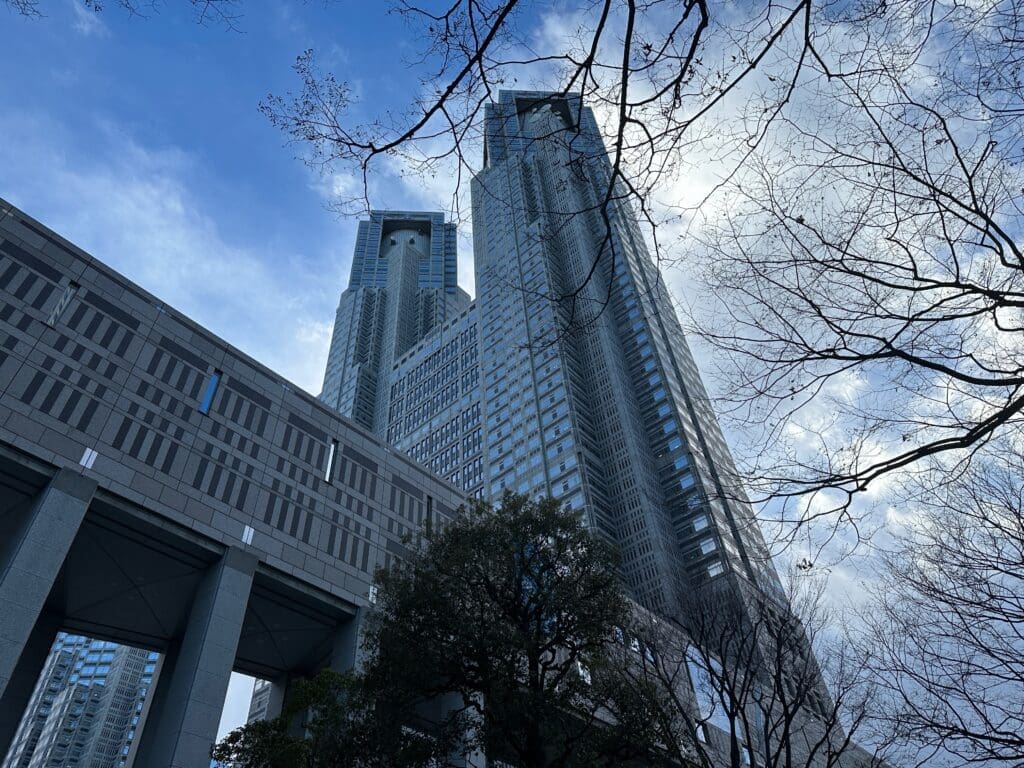
- What you’ll see: On a clear day you can pick out Meiji Jingu, Tokyo Tower, Skytree, and Mount Fuji. You’re inside the Shinjuku cluster, so it’s less about a postcard of Shinjuku and more about watching the city stretch to the horizon in every direction.
- Hours and access: The North Observatory typically runs 9:30 AM–11:00 PM and the South 9:30 AM–5:30 PM, with closures on certain dates. One tower is often closed while the other is open, so check the signs downstairs. Elevators leave from the first floor; expect a quick bag check.
- On-site perks: There’s a cafe and a small souvenir shop. The Tourist Information Center on the ground floor runs free building tours if you’re into architecture.
- Photo and comfort tips: Tripods aren’t allowed. At night there can be window reflections from interior lights, so press your lens close to the glass or stick to the corners where glare is lower. I like late afternoon into sunset here. It’s free, so even if clouds roll in, you haven’t lost anything but time.
Personal take: If you’re staying around Shinjuku, this is the one I recommend dropping into between plans. I’ve sneaked in for 20 minutes on crystal-clear winter days and came away with a Fuji silhouette you’d never expect from central Tokyo.

Bunkyo Civic Center
When open, this is the free view I send people to for an “ah, that’s Tokyo” moment: the dome of Tokyo Dome in the foreground, Skytree stabbing the sky to the east, and Shinjuku’s spikes to the west. The lounge sits on the 25th floor, and the slanted windows that jut over the street give you a clean angle that’s shockingly good for photos.
- Status: Currently closed for renovation and scheduled to reopen in early December 2026.
- Usual details when open: Free entry, typically 9:00 AM–8:30 PM. Tripods are not permitted. Access is easiest from Korakuen or Kasuga stations.
- Why it stands out: The angle is unique. You’re not too high, so you keep depth and scale in your shots, and the city feels close instead of remote.
- When to go (post-reopen): Clear afternoons for Fuji in winter, or blue hour when Skytree lights up.
Personal take: I used to bring visiting friends here after Tokyo Dome City. We’d ride the elevator up for a calm 15-minute reset and get a clean “east vs. west Tokyo” sweep without paying a yen.
Ikebukuro Sunshine 60 Sky Circus
Sunshine 60 was once Japan’s tallest building, and its observatory has leaned into fun. The “Sky Circus” is an indoor deck with interactive exhibits and optional VR rides. It’s not the tallest or most central, but it’s a solid mix of city views and entertainment.

- Admission and hours: From ¥700 to ¥1,200 for entry, depending on days and seasons. You can book your ticket on Klook. Typically 10:00 AM–10:00 PM, with ticket sales until around 8:50 PM. Some rides cost extra.
- Views and vibe: You get long views across northern and western Tokyo, elevated highways curling below, and Mount Fuji on those crisp winter days. Because Ikebukuro is a step out from the city center, it feels less touristy.
- Photography: Tripods are allowed, which is rare in Tokyo. If you care about long exposures at night, this is a big deal. Bring a small travel tripod and you’ll be happy.
- Pair it with: Sunshine City’s shops and restaurants, or a stop at the big character stores in the complex. With kids in tow, this one is an easy win.
Personal take: I suggest coming late afternoon, walking the floor slowly, then grabbing a spot as the city lights come on. If the VR rides have a line, skip them and enjoy the windows. The view is the best ride anyway.
Yebisu Garden Place Sky Lounge
On the 38th floor of Yebisu Garden Place Tower, the Sky Lounge is a quiet, free space with big windows and a surprisingly intimate view of Tokyo Tower to the east.
- Hours and access: 11:00 AM–11:30 PM. Take the “Top of Yebisu” elevator from the tower lobby. The viewing area is small, so be ready to wait a few minutes for the best window.
- What you’ll see: Tokyo Tower framed with low-rise neighborhoods in the foreground, a slice of Roppongi, and if the air is clear, a long sweep toward the bay.
- When to go: Blue hour. The tower glows, the city still has detail, and you can wander downstairs to dinner. There are good restaurants in the complex, so I like popping up here before or after a meal.
- Notes: It’s a lounge, not a full observatory. No tripods, no big setup, just a calm place to take a breath and enjoy the view.
Personal take: If you’ve been trying to photograph Tokyo Tower from somewhere other than Tokyo Tower itself, this is one of the easiest, most relaxed spots to do it without spending anything.
Tower Hall Funabori
Way out in Edogawa, Tower Hall Funabori is a different side of Tokyo entirely. It’s a community facility with an observatory level, free to enter, and almost never crowded.
- Hours and cost: 9:00 AM–9:30 PM. Free entry.
- Photography: Tripods are not allowed, but this is still a rewarding stop for photographers. Bring a telephoto lens if you have one. You can compress Skytree against the sea of low-rise rooftops, or frame it with rivers and bridges for something you can’t get downtown.
- Why go: The perspective is unique. Tokyo stretches out flat and endless here, with trains crossing tributaries and the skyline way off in the distance. It’s a good reminder that most of Tokyo is not skyscrapers.
- Who it’s for: View hunters who want something different, anyone staying on the east side of the city, and photographers collecting fresh angles of Skytree.
Personal take: I wouldn’t cross the city just for this if you’re pressed for time. But if you have a spare evening on the Toei Shinjuku Line, it’s an easy detour that pays off with photos you won’t see all over social media.
Unique and Alternative Viewing Experiences
Not in the mood to queue for a formal observatory? Tokyo rewards you if you get a bit creative. My favorite way to take in the skyline these days is to pair one classic deck with one relaxed alternative: a rooftop bar, a restaurant with a window seat, a hotel room aimed at Tokyo Tower, or a public skylobby where you can sit for a while. You usually trade a ticket for a drink, get a chair, and you get to actually see Tokyo Tower or Skytree in your photos instead of standing inside them.
Skyline Dining and Hotel Views
If you want the view without the turnstiles, head for restaurants and bars on upper floors. They’re perfect at sunset and after dark, and you don’t have to rush.
Andaz Toranomon Hills Rooftop Bar: High, dramatic views over central Tokyo with Tokyo Tower not far away. It’s a polished spot and one of the best “wow” moments in the city. Some places charge extra for window seats or have a minimum spend; Andaz has done this in the past. If the weather’s decent, I recommend arriving 30 minutes before sunset to settle in.
Prince Park Tower Tokyo (bar): This one sits almost next door to Tokyo Tower. At night the tower fills your frame and the city stretches behind it. It’s hard to beat if your priority is getting the tower in the shot. I like this for a slower pace after a busy day in Minato.
Mandarin Oriental Tokyo (lounge and bars): Perched over Nihonbashi with vast sightlines in every direction. On clear winter days I’ve seen Fuji shimmer past the city. If you’re happy to splurge on a drink and take your time, this is one of the most comfortable ways to see the city glow.
BelloVisto (Cerulean Tower, Shibuya): Classic Shibuya panorama with a calmer mood than the scramble below. Great for watching trains and towers layer together.
New York Bar (Park Hyatt Tokyo, Shinjuku): Iconic for a reason. Live music, high ceilings, and that wall of glass into the Shinjuku skyline. Go at blue hour for the best color and fewer reflections.
CÉ LA VI Tokyo (Shibuya): Lower than Shibuya Sky, but that’s part of the charm. Open-air terrace when the weather cooperates, and you feel close to the city instead of far above it.
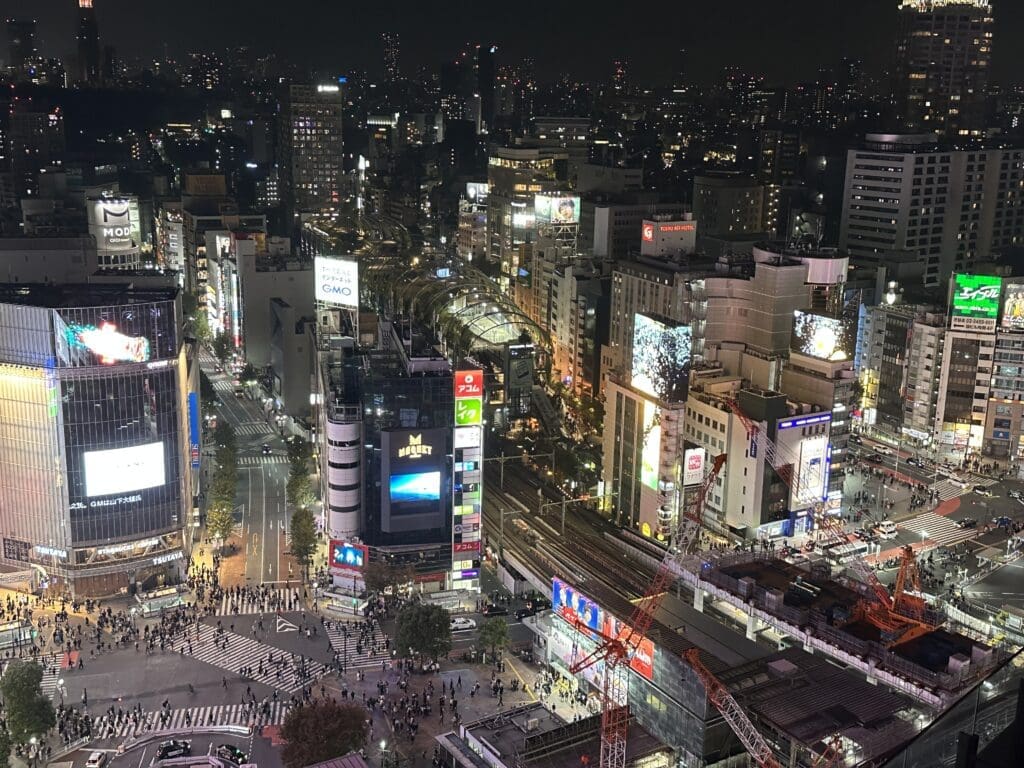
Practical dining tip: many towers keep their best city views on the restaurant floors. At Tokyo Skytree’s Solamachi, the 30th and 31st floors offer excellent vistas without buying an observatory ticket. If you just want a meal with a view and to watch the neighborhood buzz below you, it’s a great value move.
Hotel rooms can be the most relaxed “observatory” of all. If you can swing it, I recommend doing one night with a view-focused room:
- For Tokyo Tower: The Prince Park Tower Tokyo and Tokyo Prince Hotel both sell rooms facing the tower. Request “Tower View” and a higher floor. Watching the tower light up from bed is honestly better than being inside it.
- For Shinjuku: Park Hyatt Tokyo’s upper floors give sweeping views over the west side of the city.
- For central Tokyo: Andaz Toranomon Hills rooms have big windows and sightlines toward the core.
A few notes from experience:
- Reservations help for window seats. If a place offers a specific “view” seating category, pick it.
- Dress codes at high-end bars are a thing. Nothing overly formal, just avoid sportswear.
- Photography is easier at blue hour when the sky matches interior light. Press your lens to the glass or shade it with a sleeve to cut reflections. Tripods won’t fly in bars.
Office and Public Lobbies
Tokyo sprinkles free or low-key viewpoints into office towers and complex lobbies. They’re perfect when you want a short break, a view, and no ticket lines.
Azabudai Hills Skylobby (Mori JP Tower): On the 33rd floor with a close-up of Tokyo Tower. Admission is free, but as of April 18, 2024, access is limited to patrons of Dining 33, Pâtisserie à la Maison, or Sky Room Cafe & Bar. Hours are 10:45–21:00. It’s not a place to camp out: no lingering, no selfie sticks, and no tripods. For a quick look after coffee, though, it’s excellent.
Hikarie Sky Lobby (Shibuya): The 11th-floor lobby is free and open until midnight, with a straight-on view of Shibuya Crossing and the 109 building. If you want a “you can actually see people and cars” angle rather than a high-altitude map view, this is the one. I sometimes use it as a weather check before deciding if Shibuya Sky is worth it that day.


Yebisu Garden Place Sky Lounge: Free on the 38th floor and open late, with an east-facing angle good for Tokyo Tower. The viewing area is small, so be mindful of others. Use the “Top of Yebisu” elevator.
Carrot Tower (Sangenjaya): A local favorite on the 26th floor with a totally different feel from central Tokyo. It’s free, there’s often a casual bar or music in the evenings, and on clear days Fuji can line up nicely. If you’re exploring Setagaya or looking for a quieter detour, this is worth the ride.
Shibuya Parco Rooftop: An open-air terrace rather than a sealed lobby, but it functions the same way in practice. It’s free, has seating, and gives you low-to-mid height city views that feel close and lively. I like going up via the indoor escalators and wandering down the external staircase.
- Asakusa Culture Tourist Information Center: The top floor from this stylish building located right across Senso-ji temple offers amazing views over Nakamise Shopping Street and Asakusa skyline. I usually stop by whenever I’m in the area. There’s a small free viewing deck, but the cafe next to it has a much better view. Just keep in mind that you’ll need to order at least a drink.


How to use these well:
- Policies change and these spaces close for events more often than you’d expect, so have a backup nearby.
- Most ban tripods and selfie sticks; security will say something if you set up. A small camera or phone is perfect.
- For photos through glass, angle away from interior lights or use a sleeve to block reflections. You’ll get cleaner shots, especially at night.
- Weekdays an hour before sunset are usually calm. You’ll catch golden hour, then the evening lights, without a crowd.
Practical Tips for Visiting Tokyo’s Observation Decks
You can see Tokyo from dozens of angles, but a little planning makes the difference between a smooth, wow-filled visit and a long queue with foggy photos. Here is how I plan my own skyline time.
Ticketing and Entry
- Book timed tickets for the big sunset slots. Shibuya Sky often sells out on nice days, especially for late afternoon. I suggest buying in advance for your preferred time. Adult tickets are around ¥2,700 and you choose a 20–30 minute entry window. The rooftop can temporarily close for wind or rain, so keep an eye on day-of notices.
- Skytree uses date- and time-based pricing and often gives a small discount online. If your dates are fixed, it is worth booking ahead, especially for weekends or holidays. Lines for the elevator can get long at peak hours, both up and down. If you want to watch day turn to night from Skytree, plan extra buffer time.
- Tokyo Tower’s Main Deck is generally easy to visit on the day, but the Top Deck requires a reservation and commonly sells out. If the Top Deck is important to you, lock it in early. If not, you can keep Tokyo Tower flexible and decide based on weather.
- Free entries still exist and are great for filling gaps in your day. The Tokyo Metropolitan Government Building in Shinjuku has complimentary observatories. Bunkyo Civic Center is also free but is closed for renovation until early December 2026. Yebisu Garden Place’s Sky Lounge and Tower Hall Funabori are free and reliable options if you want quick views without planning. Azabudai Hills’ 33rd-floor Skylobby is free only if you are a patron of the eateries there, and it has strict rules on photography and lingering.
- Bundles can help if you plan multiple decks. Certain passes sometimes include Shibuya Sky, Tokyo City View, Skytree, and Tokyo Tower as add-ons. If your itinerary already includes several paid decks, check pass math before you buy single tickets.
- Weather rarely gets you a refund. Most observatories state clearly that tickets are nonrefundable for clouds or low visibility. If your trip is flexible, I recommend booking one must-see at a fixed time and keeping a second deck as a spontaneous pick for the clearest day.
- Expect security and bag rules. Shibuya Sky requires you to store bags and loose items in lockers at the top before you go to the roof. Bring a ¥100 coin for the locker deposit, which you’ll get back. Selfie sticks are widely banned. Even if you booked a precise timeslot, allow a few extra minutes for checks before the elevator.
- Check closures and policy changes. Roppongi Hills’ rooftop Sky Deck is closed to the public until further notice and not part of the regular ticket anymore. The old World Trade Center “Seaside Top” observatory was shut during redevelopment and is gone. Deck policies shift more than you’d think, so I always confirm the latest hours and access on the day I plan to go.
Photography and Accessibility
- Tripods are mostly a no. Skytree, Tokyo Tower, the Tokyo Metropolitan Government Building, Bunkyo Civic Center, and Azabudai Hills’ Skylobby prohibit tripods. Mori Tower’s main indoor deck sometimes allows them unless it is crowded, but do not count on it. If you truly need a tripod, Sunshine 60’s Sky Circus allows them. Chiba Port Tower allows them too, though it is out by the bay. For central Tokyo, I leave the tripod at the hotel and work handheld.
- Beat reflections from glass. Most decks are indoors behind glass, so reflections are your enemy after dark. Wear darker clothes, press your lens close to the window, and shield the edge with your hand or a jacket. Turn off your camera’s screen brightness if it is reflecting back. A polarizer helps in daylight but not much at night. A small microfiber cloth is handy because windows pick up smudges fast.
- Open-air solves the glare problem. This is where Shibuya Sky shines for photos. You get clean shots at sunset and night without fighting reflections. The trade-off is wind and occasional roof closures for safety. Staff are strict about loose items, which keeps the experience calm but means changing lenses or juggling gear is not practical up there.
- Colored lighting inside can spoil photos. Tokyo Tower sometimes has interior lighting that flares into your frame. If photography is your main goal, I prefer shooting Tokyo Tower from elsewhere, like Roppongi’s City View deck or free spots in Ebisu or Shibuya. You cannot photograph Tokyo Tower while you are inside it anyway.
- Accessibility is generally good. Major observatories have elevators and accessible restrooms. Indoors is straightforward for wheelchairs and strollers. Rooftops are trickier. Shibuya Sky has stepped seating and wind restrictions; staff can guide you to accessible routes, but some areas may be limited when the rooftop is busy or gusty. If you are visiting with small kids, indoor decks like Sunshine 60 are easier to manage, with places to sit and snack.
Visiting at the Best Times
- Sunset into night is the crowd (and my) favorite for a reason. Watching the city light up never gets old. Arrive 60 to 90 minutes before sunset to secure a good spot and see both sides of the light. If you only pick one time for a deck, make it this.


- Clear mornings are underrated. On crisp days, especially in winter, you get long views and Mount Fuji sightings without the sunset crowd. Skytree is excellent by day because you can actually make out the geography rather than just a blanket of lights. I like mornings after a rain when the air is scrubbed clean.
- Night views work better from “mid” heights. If you want to feel Tokyo’s density, indoor decks around the 200–250 meter mark are great at night. You are high enough for wide panoramas but close enough to trace roads and neighborhoods. From very high up, the city can flatten into dots of light.
- Winter is Fuji season. You have the best odds of seeing Mount Fuji from late autumn through winter on cold, dry days. Summer is hazier, and the mountain often hides behind clouds. If a clear winter day pops up in your forecast, reshuffle plans and go.
- Weekdays beat weekends. Monday to Thursday is calmer almost everywhere. Holidays are crowded. If you must go on a weekend, go early or go late. Some decks are open until 10 or 11 pm; the last hour can be surprisingly peaceful.
- Build in slack for delays. Tokyo’s tall buildings can sway slightly, and even a minor quake or wind spike can slow elevator operations. I do not schedule a tight dinner reservation right after a sunset slot. Give yourself time to get down.
- If Tokyo Tower or Skytree are your dream photos, shoot them from somewhere else. Many people realize too late that you cannot see the landmark you are inside. For Tokyo Tower, Roppongi, Ebisu, or even Azabudai’s Skylobby put the tower in your frame. For Skytree, consider Asakusa banks or the restaurant floors at Solamachi.

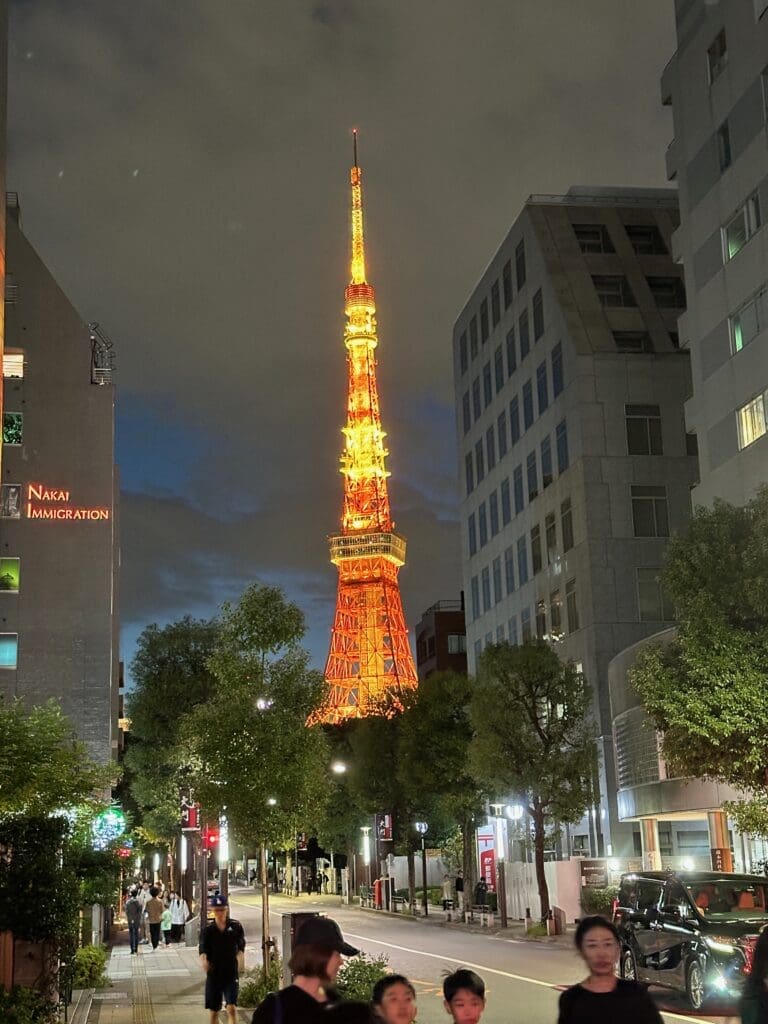
With the right timing and a little strategy, you can see Tokyo at its best without stress. Pick one must-do, keep one flexible, and chase the clearest window in your week. That simple plan has never failed me.
The Bottom Line
Tokyo’s skyline really isn’t something you can cover in a single view or snapshot. The truth is, your best experience won’t just come from finding the highest spot or the best-known tower, but from matching the vibe to your own plans. Night or day, rainy or clear, there’s always a way to fit a skyline moment into your trip if you keep your options open and avoid chasing perfection. Pick one spot that lines up with your mood, maybe try a quieter or unexpected location, and leave some space in your schedule for whatever weather or energy Tokyo throws at you.





